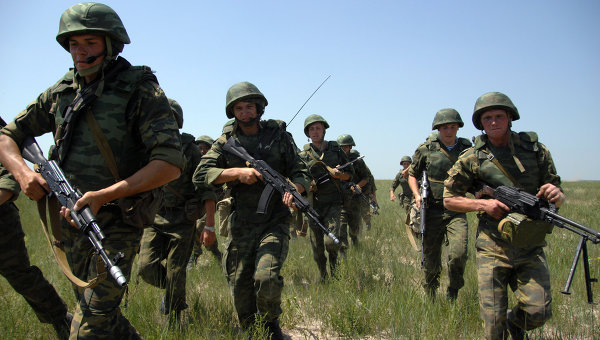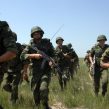
Russian Combat Readiness Declines In the “New Look”
Publication: Eurasia Daily Monitor Volume: 8 Issue: 105
By:

The Russian armed forces are preparing to test their “new look” brigades later this year in the operational-strategic exercise Tsentr 2011. Despite the transition to the brigade-based structure in 2009 and efforts to strengthen such formations, the level of combat readiness has declined since the reform was initiated in October 2008. On May 4, Yury Belousov interviewed the Deputy Commander of Central Military District (MD), Major-General Sergey Istrakov, examining training, equipment and preparations for the forthcoming exercise. Istrakov outlined the work involved in forming the new MD and claimed that its combat capabilities “significantly surpassed” the strength of formations in the previous MD structure, despite the reported problems concerning introducing modern weapons and equipment (Krasnaya Zvezda, https://www.redstar.ru/2011/05/04_05/2_01.html, May 4).
Istrakov characterized Tsentr 2011 as a significant test for the district’s manpower in the training year. Part of the preparation involves a series of mobilization exercises, as well as more than 20 command-staff exercises. A field assembly has been conducted for Radiation, Chemical and Biological Defense troops, while combat training has occurred in four ranges in the Central MD involving 1,500 servicemen and 600 pieces of equipment. Training of reconnaissance personnel has also intensified. Istrakov stated that 90 percent of battalion level personnel are conscripts drafted in 2010 (Krasnaya Zvezda, May 4).
The deputy commander of the Central MD was keen to emphasize the intensification of combat training. Organizational training, in his view, now fills the entire ten month training period annually, and consequently troops are involved in battalion-level and artillery organizational training from August to September, as a precursor to brigade-level tactical exercises “with or without” live firing. During this phase, Istrakov said that officer instructor training has been cut back in order to focus on the intensity of the drills. In the “new look” brigades, a typical combat training day lasts for six to eight hours, compared with the five hours reportedly devoted to sports and physical fitness training. Officers that arrived in these formations from the disbanded cadre or skeleton units are failing to meet training demands. Sub-unit command-level officers are struggling to find time for individual training and to write notes for the next combat training day. In order to remedy this weakness, additional lectures and training have been provided for these officers (Krasnaya Zvezda, May 4).
In terms of the manpower within the brigades, therefore, conscripts serving for twelve months are trained in three months instead of the former period of five months, with shortcuts to achieve this “intensification.” Servicemen spend “five hours” per day in non-combat training (unlikely, as the body needs time to recover), one hour having an “afternoon nap,” and six to eight hours in combat training using mostly obsolete weapons and equipment. The brigades rely heavily upon conscripts, as contract personnel numbers have been reduced, while no new “professional” non-commissioned officers (NCOs) are involved. The ability of the armed forces to deploy such units is therefore limited at best (https://nvo.ng.ru/concepts/2011-05-13/1_reform.html, May 13; VPK, April 13).
It is important to understand how the Russian top brass define critical terms and assess combat readiness, and to contextualize statements made by senior officials or commanders about the “progress” of the reform. Combat effectiveness is defined by the capability and ability of formations to conduct military operations successfully and execute assigned combat missions, either partially or fully in accordance with their purpose. The key elements of combat effectiveness are combat readiness and combat capability (Voyna i mir v terminakh i opredeleniyakh, https://www.voina-i-mir.ru/dicdefinition/?id-620 https://www.voina-i-mir.ru/dicdefinition/?id-620).
The combat potential of troops represents the maximum scope of combat missions that can be executed by the forces involved in conducting operations; this indicator is derived from the level of equipment in the armed forces, personnel numbers and strength of units and formations in cadres of military specialists with the necessary qualifications, and their morale. Measuring combat readiness involves both objective and subjective factors, such as how long it takes to bring a unit from peacetime readiness to being able to conduct operations, and a subjective factor such as a recent change of command. When the Russian top brass discuss combat readiness, in terms of personnel, they exclude conscripts from the measurement and concentrate on the contract elements serving in “positions that determine the level of combat readiness,” which relates to more demanding functions such as armored vehicles, mechanics/drivers, snipers, missile launching operators and other specialists (Interfax, May 27, 2010; Vooruzheniye i Ekonomika, No 3, 2009; Voennaya Mysl, No. 1, 2009).
General Istrakov, referring to changes in command and control and the introduction of “new methods” of conducting military operations, highlighted challenges facing officer selection and training. During Tsentr 2011, automated command and control systems will again be tested, which has become a common theme in recent Russian military exercises, and consequently officers must master electronic-computer equipment. “The most worthy officers, including from disbanded Siberian MD, were offered the opportunity to continue service in the Central MD that was being formed. During conducting individual certification, the officer’s worldview, his ability to work on automated command and control systems equipment, and creative initiative and the ability to make independent decisions were mandatorily taken into account,” Istrakov stated (Krasnaya Zvezda, May 4). This level of technical sophistication is way beyond the potential of twelve month serving conscripts, and is evidently much more narrowly focused.
A mixture of various experimental elements will be tested during Tsentr 2011. Yet, claims made by the defense ministry about enhanced levels of combat readiness are merely aimed at internal consumption, and are only given credence among non-military specialists. Combat readiness has declined in the brigades, and there is little chance that this will be corrected soon. Conscript personnel participating in Tsentr 2011 are anomalous in terms of overall combat readiness, while the General Staff will be interested in experimental communications systems, officer performance and the “proficiency” of kontraktniki involved in the exercise. In the absence of a properly functioning NCO cadre, and with an emphasis on mobilization, Tsentr 2011 will display the strange contradictions at the heart of the Russian armed forces’ transition to becoming a more effective force. Unfortunately, despite the claims surrounding the “reform” and its alleged advances, the wizened ears of the old look will prove impossible to hide.




